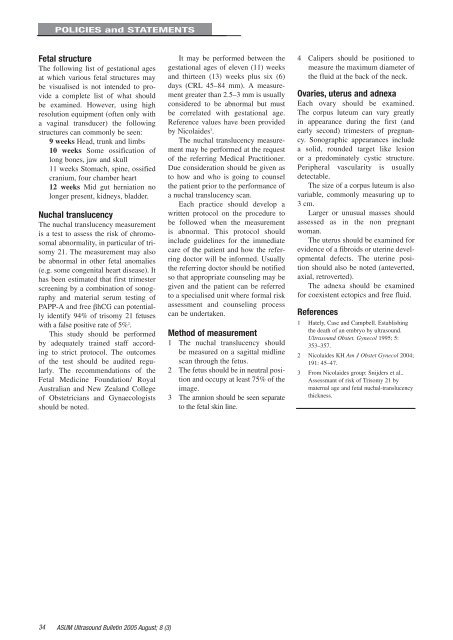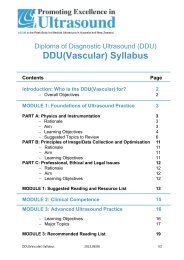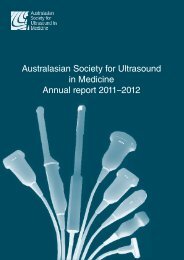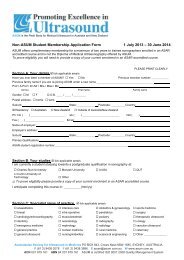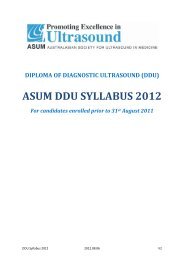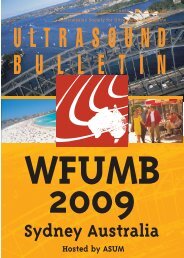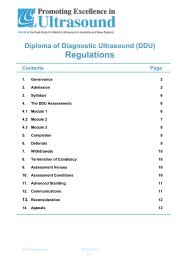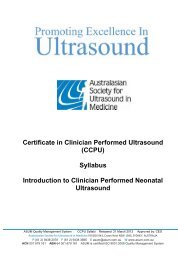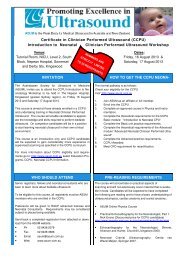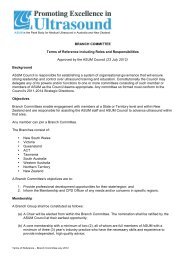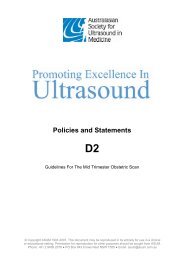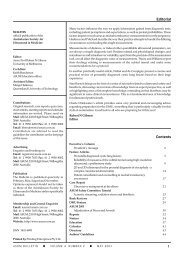Volume 8 Issue 3 - Australasian Society for Ultrasound in Medicine
Volume 8 Issue 3 - Australasian Society for Ultrasound in Medicine
Volume 8 Issue 3 - Australasian Society for Ultrasound in Medicine
Create successful ePaper yourself
Turn your PDF publications into a flip-book with our unique Google optimized e-Paper software.
POLICIES and STATEMENTSFetal structureThe follow<strong>in</strong>g list of gestational agesat which various fetal structures maybe visualised is not <strong>in</strong>tended to providea complete list of what shouldbe exam<strong>in</strong>ed. However, us<strong>in</strong>g highresolution equipment (often only witha vag<strong>in</strong>al transducer) the follow<strong>in</strong>gstructures can commonly be seen:9 weeks Head, trunk and limbs10 weeks Some ossification oflong bones, jaw and skull11 weeks Stomach, sp<strong>in</strong>e, ossifiedcranium, four chamber heart12 weeks Mid gut herniation nolonger present, kidneys, bladder.Nuchal translucencyThe nuchal translucency measurementis a test to assess the risk of chromosomalabnormality, <strong>in</strong> particular of trisomy21. The measurement may alsobe abnormal <strong>in</strong> other fetal anomalies(e.g. some congenital heart disease). Ithas been estimated that first trimesterscreen<strong>in</strong>g by a comb<strong>in</strong>ation of sonographyand material serum test<strong>in</strong>g ofPAPP-A and free βhCG can potentiallyidentify 94% of trisomy 21 fetuseswith a false positive rate of 5% 2 .This study should be per<strong>for</strong>medby adequately tra<strong>in</strong>ed staff accord<strong>in</strong>gto strict protocol. The outcomesof the test should be audited regularly.The recommendations of theFetal Medic<strong>in</strong>e Foundation/ RoyalAustralian and New Zealand Collegeof Obstetricians and Gynaecologistsshould be noted.It may be per<strong>for</strong>med between thegestational ages of eleven (11) weeksand thirteen (13) weeks plus six (6)days (CRL 45–84 mm). A measurementgreater than 2.5–3 mm is usuallyconsidered to be abnormal but mustbe correlated with gestational age.Reference values have been providedby Nicolaides 3 .The nuchal translucency measurementmay be per<strong>for</strong>med at the requestof the referr<strong>in</strong>g Medical Practitioner.Due consideration should be given asto how and who is go<strong>in</strong>g to counselthe patient prior to the per<strong>for</strong>mance ofa nuchal translucency scan.Each practice should develop awritten protocol on the procedure tobe followed when the measurementis abnormal. This protocol should<strong>in</strong>clude guidel<strong>in</strong>es <strong>for</strong> the immediatecare of the patient and how the referr<strong>in</strong>gdoctor will be <strong>in</strong><strong>for</strong>med. Usuallythe referr<strong>in</strong>g doctor should be notifiedso that appropriate counsel<strong>in</strong>g may begiven and the patient can be referredto a specialised unit where <strong>for</strong>mal riskassessment and counsel<strong>in</strong>g processcan be undertaken.Method of measurement1 The nuchal translucency shouldbe measured on a sagittal midl<strong>in</strong>escan through the fetus.2 The fetus should be <strong>in</strong> neutral positionand occupy at least 75% of theimage.3 The amnion should be seen separateto the fetal sk<strong>in</strong> l<strong>in</strong>e.4 Calipers should be positioned tomeasure the maximum diameter ofthe fluid at the back of the neck.Ovaries, uterus and adnexaEach ovary should be exam<strong>in</strong>ed.The corpus luteum can vary greatly<strong>in</strong> appearance dur<strong>in</strong>g the first (andearly second) trimesters of pregnancy.Sonographic appearances <strong>in</strong>cludea solid, rounded target like lesionor a predom<strong>in</strong>ately cystic structure.Peripheral vascularity is usuallydetectable.The size of a corpus luteum is alsovariable, commonly measur<strong>in</strong>g up to3 cm.Larger or unusual masses shouldassessed as <strong>in</strong> the non pregnantwoman.The uterus should be exam<strong>in</strong>ed <strong>for</strong>evidence of a fibroids or uter<strong>in</strong>e developmentaldefects. The uter<strong>in</strong>e positionshould also be noted (anteverted,axial, retroverted).The adnexa should be exam<strong>in</strong>ed<strong>for</strong> coexistent ectopics and free fluid.References1 Hately, Case and Campbell. Establish<strong>in</strong>gthe death of an embryo by ultrasound.<strong>Ultrasound</strong> Obstet. Gynecol 1995; 5:353–357.2 Nicolaides KH Am J Obstet Gynecol 2004;191: 45–47.3 From Nicolaides group: Snijders et al..Assessmant of risk of Trisomy 21 bymaternal age and fetal nuchal-translucencythickness.34 ASUM <strong>Ultrasound</strong> Bullet<strong>in</strong> 2005 August; 8 (3)


